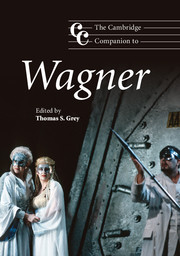Book contents
- Frontmatter
- PART I Biographical and historical contexts
- PART II Opera, music, drama
- 4 The “Romantic operas” and the turn to myth
- 5 Der Ring des Nibelungen: conception and interpretation
- 6 Leitmotif, temporality, and musical design in the Ring
- 7 Tristan und Isolde: essence and appearance
- 8 Performing Germany in Wagner's Die Meistersinger von Nürnberg
- 9 Parsifal: redemption and Kunstreligion
- PART III Ideas and ideology in the Gesamtkunstwerk
- PART IV After Wagner: influence and interpretation
- Notes
- Select bibliography
- Index
9 - Parsifal: redemption and Kunstreligion
from PART II - Opera, music, drama
Published online by Cambridge University Press: 28 September 2011
- Frontmatter
- PART I Biographical and historical contexts
- PART II Opera, music, drama
- 4 The “Romantic operas” and the turn to myth
- 5 Der Ring des Nibelungen: conception and interpretation
- 6 Leitmotif, temporality, and musical design in the Ring
- 7 Tristan und Isolde: essence and appearance
- 8 Performing Germany in Wagner's Die Meistersinger von Nürnberg
- 9 Parsifal: redemption and Kunstreligion
- PART III Ideas and ideology in the Gesamtkunstwerk
- PART IV After Wagner: influence and interpretation
- Notes
- Select bibliography
- Index
Summary
The long road to Parsifal
The Ring complete, the Bayreuth festival a fragile reality, Wagner turned – or more precisely returned, after a long hiatus – to work on Parsifal in 1877. He finished the poetic text in April and then labored for five years on the music, fighting ill health and struggling to ensure the future of the festival along the way. He composed act by act, drafting “compositional” and “orchestral” sketches virtually simultaneously, sometimes making use of material conceived earlier and occasionally revising the verbal text. After finishing the orchestral sketch in April 1879, Wagner needed almost three years until he concluded work on the full score, in January 1882. Further revisions and rehearsals fraught with diverse problems preceded the first performances in the summer of 1882, when the aging master celebrated himself and his achievement by conducting the last act of the final performance – a true Schwanengesang.
The opera Parsifal is a “summation and consummation,” a late work and Wagner's self-described “last card.” He drew it from a very mixed deck that he had begun to assemble already in the 1840s. In the intervening decades he completed an intellectual and artistic journey whose course was defined by the many twists and turns, detours and reversals, through which the opera accrued a rich assortment of philosophical ideas and poetic-dramatic and musical elements. If Wagner had composed a “Parzifal” on Wolfram von Eschenbach's medieval epic in 1845, when he first read the poem, it would have joined Tannhäuser and Lohengrin to form a trilogy of Romantic operas on medieval Christian legends.
- Type
- Chapter
- Information
- The Cambridge Companion to Wagner , pp. 151 - 176Publisher: Cambridge University PressPrint publication year: 2008
- 3
- Cited by

